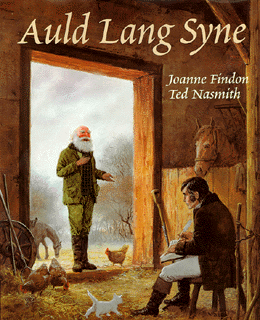|
Celebrate the New Year with a New Book: Auld Lang Syne
A new book will inspire appreciation for the life of Robert Burns, the great Scottish poet, and for the oft-sung words of what is probably his most famous work -- "Auld Lang Syne."
Should auld acquaintance be forgot
And never brought to mind?
Should auld acquaintance be forgot,
And days of auld lang syne?
(refrain)
For auld lang syne, my dear,
For auld lang syne?
We'll take a cup of kindness yet
For auld lang syne.
We two have run about the braes,
And pulled the gowans fine,
But we've wandered many a weary fit
Since auld lang syne.
And there's a hand my trusty fiere,
And give's a hand of thine,
And we'll take a right guid-willie waught,
For auld lang syne.
How many times have you heard or sung those words? What meaning do they hold for you?
 Those oft-sung lyrics are the words of a poem penned by the Scottish poet Robert Burns in the late 1700s. The words have powerful meaning -- especially when viewed in the context of Burns's life. They sing of the joy of friendships long remembered, friendships never to be forgotten.
Those oft-sung lyrics are the words of a poem penned by the Scottish poet Robert Burns in the late 1700s. The words have powerful meaning -- especially when viewed in the context of Burns's life. They sing of the joy of friendships long remembered, friendships never to be forgotten.
Seldom has the meaning of those words been quite so clear as it is in a new children's book by Joanne Findon, Auld Lang Syne (Stoddart Kids, 1997).
"AULD LANG SYNE" COMES FROM THE HEART --
AND FROM LIFE -- OF ROBERT BURNS
Findon tells the story of Robert Burns in the first person. Although the family was poor in material ways, they enjoyed a life rich in more important things.
"Father was a poor tenant farmer who toiled all day in the fields. Our food was plain peasant fare: kale and potatoes when we had them, and meat only rarely. Sometimes we had nothing but porridge for our supper. Our cottage was long and low, and had only four small windows. Yet this was a house lit with laughter and song, and the bonds of love meant more to us than wealth."
Burns tells of friends from school days, of writing poems on his slate whenever he had a free moment from tending the family's fields, and of meeting Jean Armour, "the bonnie, dark-haired lass" who would become his wife. And linked to each of those biographical stories are some of the words of Burn's most famous poem.
In Findon's story, Burns tells of his experiences reading poems for the elite of Edinborough society and of his need to return to his farmland roots. He tells of one day fleeing the "clamour of Edinburgh's streets" with a new friend, painter Alexander Naysmyth. The two men climbed to a rocky precipice overlooking cramped rows of city houses, beyond which stretched miles of countryside sprinkled with little dwellings.
"As we stood in the sun admiring the vista, I told Alexander, 'The sight of so many smoking cottages reminds me of all the happiness and worth that each one contains.' And I knew with great certainty that I would never be at home among the noble families of Edinburgh. My heart would ever dwell among the peasant folk.
"We two have run about the braes,
And pulled the gowans fine,
But we've wandered many a weary fit
Since auld lang syne."
Findon's book includes a glossary that students can use to translate the words of Burns's most famous poem and to see clearly how its words fit the context of his life. A quick check of the glossary yields definitions of brae (hillside beside a river), gowans (daisies), fit (footstep), and "auld lang syne" (good old times).
ILLUSTRATIONS WITH A CONNECTION!
The illustrations in Auld Lang Syne are done in the classical style, not unlike the style of Burn's friend Alexander Naysmyth. (Naysmyth's portrait of Robert Burns, pictured in the book's introduction, hangs in The Scottish National Portrait Gallery.) And it is no coincidence that the book's illustrator happens to have the same last name as Burns's cherished "auld acquaintance." Ted Naismith's roots take him back to Scotland -- and to his ancestor, Alexander Naysmyth!
Naismith has earned an international reputation illustrating Tolkein's books and calendars. Students will find comfort in his work in Auld Lang Syne. The illustrations tell Burns's life story, but more lasting will be the impression left by the books' settings and landscapes, which capture Burns's peasant life and the countryside that inspired his beautiful poetry.
HIS WORK LIVES ON!
Robert Burns, often called the "Scottish Bard," died in his late 30s in 1776. But, today, 200 years later, he is still one of the world's best-loved poets. His work is frequently quoted, but one special poem is better known than all the others. Each year, often on New Year's Eve, millions of people around the world sing Burns's traditional words "take of cup of kindness yet, for auld lang syne" as they celebrate with family and friends.
Ask your local bookseller to order a copy of Auld Lang Syne, written by Joanne Findon and illustrated by Ted Naismith. Or you can order yourself by writing to Stoddart Kids, 85 River Rock Drive, Suite 202, Buffalo, NY 14207 or calling toll-free (800)805-1083.
Article by Gary Hopkins
Education World® Editor-in-Chief
Copyright © 1998 Education World
01/05/1998
|